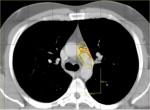New Lung-Cancer Screening Guidelines Improve Representation Among African Americans
 The US Preventive Task Force (USPSTF) new guidelines for lung-cancer screening released in 2021 show an increase in the proportion of African American patients screened in the first nine months after the guidelines took effect, according to research published in JAMA Network Open.
The US Preventive Task Force (USPSTF) new guidelines for lung-cancer screening released in 2021 show an increase in the proportion of African American patients screened in the first nine months after the guidelines took effect, according to research published in JAMA Network Open.
“Without screening, lung cancer is often discovered in late stages of the disease, when treatments are considerably less effective,” says senior author of the study and pulmonologist Julie Barta, MD, an assistant professor of medicine at Thomas Jefferson University, co-lead for the Lung Cancer, Screening, and Nodules Program at the Jane & Leonard Korman Respiratory Institute, and a researcher with the Sidney Kimmel Cancer Center. “Our goal was to test whether the new guidelines were effective at reducing disparate screening uptake in African Americans.”
The criteria first published in 2013 defined those at high risk for lung cancer as people from 55 to 80 years old who are in good health, have at least a 30 pack-year smoking history (e.g., smoking one pack of cigarettes per day for 30 years) and currently smoke or have quit within the past 15 years. In 2021, those recommendations expanded to include those between the ages of 50 – 80 and lowered the pack-year history to 20.
Together with first author and the Jefferson Lung Cancer Screening Program’s research data analyst Christine Shusted, MPH, Dr Barta and team analyzed a cohort of 815 people who underwent lung cancer screening at the Center City campus of Jefferson Health between March 9, 2021 – the date that the new guidelines were released – and December 9, 2021. For the analysis, patients were then separated by those who were eligible for screening using the 2013 guidelines (a total of 654), and those who were newly eligible by the 2021 guidelines (a total of 161 patients). The researchers then compared the proportion of African Americans in each group.
The results demonstrated that the new guidelines increased the proportion of African Americans screened. The team reported that 54% of people eligible for screening by 2021 criteria were African American, whereas only 39% were African American in the group that were eligible for screening using the 2013 criteria. “This increase in the proportion of African Americans screend is encouraging as published data indicates that African Americans, specifically, will have a greater benefit, as defined as more lives saved from lung cancer screening,” says Shusted.
While it is encouraging to see a larger cohort of African American patients getting screened thanks to the new guidelines,” says Dr Barta, “we are well aware that changing guidelines is only a first step to improving screening uptake and reducing cancer disparities. For many, significant barriers persist long before a patient ever enters the exam room, such as lack of transportation, limited clinic hours, as well as attitudes and beliefs surrounding health care and smoking,” she notes.
To address these issues, the Jefferson group is working towards expanding availability, increasing knowledge about screening, and implementing community-based approaches to outreach, especially to the historically under resourced populations in the catchment area.